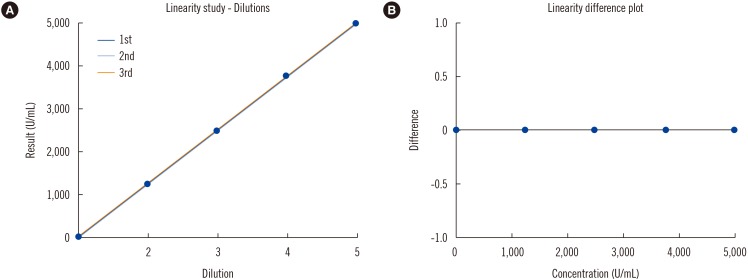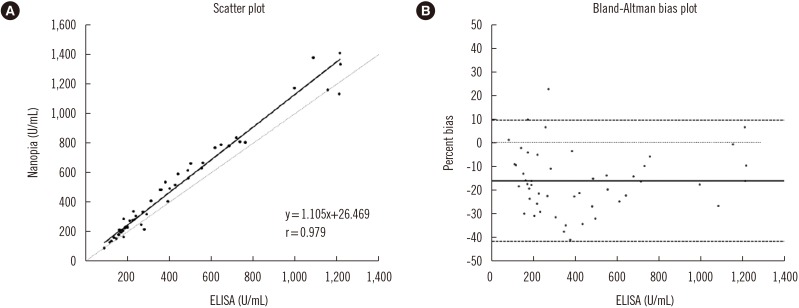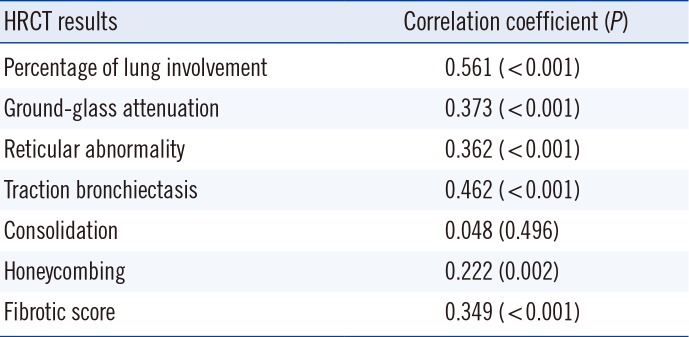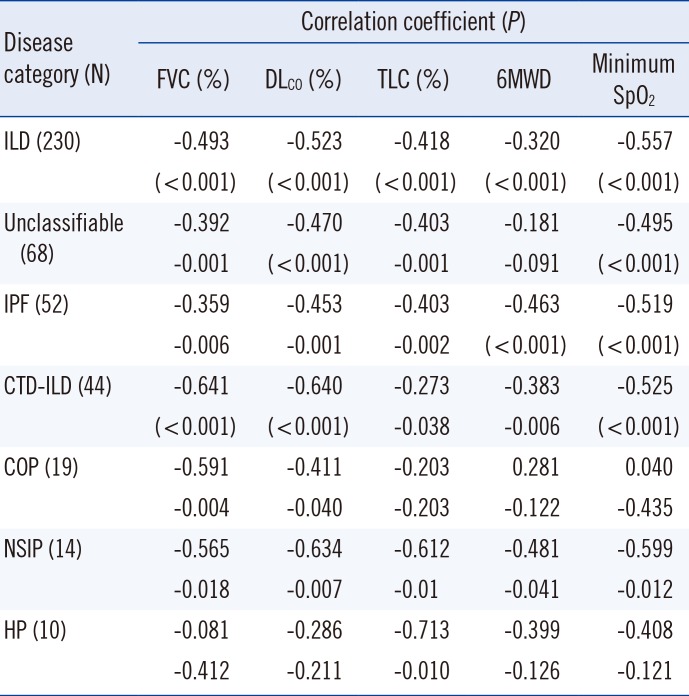1. Kohno N, Awaya Y, Oyama T, Yamakido M, Akiyama M, Inoue Y, et al. KL-6, a mucin-like glycoprotein, in bronchoalveolar lavage fluid from patients with interstitial lung disease. Am Rev Respir Dis. 1993; 148:637–642. PMID:
8368634.
2. American Thoracic Society. European Respiratory Society International Multidisciplinary Consensus Classification of the Idiopathic Interstitial Pneumonias. This joint statement of the American Thoracic Society (ATS), and the European Respiratory Society (ERS) was adopted by the ATS board of directors, June 2001 and by the ERS Executive Committee, June 2001. Am J Respir Crit Care Med. 2002; 165:277–304. PMID:
11790668.
3. National Clinical Guideline C. National institute for health and care excellence: Clinical guidelines. Diagnosis and management of suspected idiopathic pulmonary fibrosis: Idiopathic pulmonary fibrosis. London: Royal College of Physicians (UK) National Clinical Guideline Centre;2013. p. 44–51.
4. Meyer KC. Diagnosis and management of interstitial lung disease. Transl Respir Med. 2014; 2:4. PMID:
25505696.
5. Huang H, Peng X, Nakajima J. Advances in the study of biomarkers of idiopathic pulmonary fibrosis in Japan. Biosci Trends. 2013; 7:172–177. PMID:
24056167.
6. Ishikawa N, Hattori N, Yokoyama A, Kohno N. Utility of KL-6/MUC1 in the clinical management of interstitial lung diseases. Respir Investig. 2012; 50:3–13.
7. Ichiyasu H, Ichikado K, Yamashita A, Iyonaga K, Sakamoto O, Suga M, et al. Pneumocyte biomarkers KL-6 and surfactant protein D reflect the distinct findings of high-resolution computed tomography in nonspecific interstitial pneumonia. Respiration. 2012; 83:190–197. PMID:
21555868.
8. Wakamatsu K, Nagata N, Kumazoe H, Oda K, Ishimoto H, Yoshimi M, et al. Prognostic value of serial serum KL-6 measurements in patients with idiopathic pulmonary fibrosis. Respir Investig. 2017; 55:16–23.
9. Ishii H, Mukae H, Kadota J, Kaida H, Nagata T, Abe K, et al. High serum concentrations of surfactant protein A in usual interstitial pneumonia compared with non-specific interstitial pneumonia. Thorax. 2003; 58:52–57. PMID:
12511721.
10. du Bois RM, Weycker D, Albera C, Bradford WZ, Costabel U, Kartashov A, et al. Forced vital capacity in patients with idiopathic pulmonary fibrosis: test properties and minimal clinically important difference. Am J Respir Crit Care Med. 2011; 184:1382–1389. PMID:
21940789.
11. Hamai K, Iwamoto H, Ishikawa N, Horimasu Y, Masuda T, Miyamoto S, et al. Comparative study of circulating MMP-7, CCL18, KL-6, SP-A, and SP-D as disease markers of idiopathic pulmonary fibrosis. Dis Markers. 2016; 2016:4759040. PMID:
27293304.
12. Chiba S, Ohta H, Abe K, Hisata S, Ohkouchi S, Hoshikawa Y, et al. The diagnostic value of the interstitial biomarkers KL-6 and SP-D for the degree of fibrosis in combined pulmonary fibrosis and emphysema. Pulm Med. 2012; 2012:492960. PMID:
22530118.
13. CLSI. Evaluation of precision performance of quantitative measurement methods; Approved guideline. 2nd ed. Wayne, PA: Clinical and Laboratory Standards Institute;2014. CLSI document EP5-A3.
14. CLSI. Evaluation of the linearity of quantitative measurement procedures: a statistical approach; Approved guideline. Wayne, PA: Clinical and Laboratory Standards Institute;2003. CLSI document EP6-A.
15. CLSI. Measurement procedure comparison and bias estimation using patient samples; Approved guideline. 3rd ed. Wayne, PA: Clinical and Laboratory Standards Institute;2013. CLSI document EP09-A3.
16. Ichikado K, Johkoh T, Ikezoe J, Takeuchi N, Kohno N, Arisawa J, et al. Acute interstitial pneumonia: high-resolution CT findings correlated with pathology. AJR Am J Roentgenol. 1997; 168:333–338. PMID:
9016201.
17. Romei C, Tavanti L, Sbragia P, De Liperi A, Carrozzi L, Aquilini F, et al. Idiopathic interstitial pneumonias: do HRCT criteria established by ATS/ERS/JRS/ALAT in 2011 predict disease progression and prognosis? Radiol Med. 2015; 120:930–940. PMID:
25743239.
18. Pellegrino R, Viegi G, Brusasco V, Crapo RO, Burgos F, Casaburi R, et al. Interpretative strategies for lung function tests. Eur Respir J. 2005; 26:948–968. PMID:
16264058.
19. ATS statement: guidelines for the six-minute walk test. Am J Respir Crit Care Med. 2002; 166:111–117. PMID:
12091180.
20. Ishikawa N, Hattori N, Yokoyama A, Tanaka S, Nishino R, Yoshioka K, et al. Usefulness of monitoring the circulating Krebs von den Lungen-6 levels to predict the clinical outcome of patients with advanced nonsmall cell lung cancer treated with epidermal growth factor receptor tyrosine kinase inhibitors. Int J Cancer. 2008; 122:2612–2620. PMID:
18324627.
21. Matsuno Y, Satoh H, Ishikawa H, Kodama T, Ohtsuka M, Sekizawa K. Simultaneous measurements of KL-6 and SP-D in patients undergoing thoracic radiotherapy. Med Oncol. 2006; 23:75–82. PMID:
16645232.
22. Fraser CG, Hyltoft Petersen P, Libeer JC, Ricos C. Proposals for setting generally applicable quality goals solely based on biology. Ann Clin Biochem. 1997; 34(Pt 1):8–12. PMID:
9022883.
23. Tate J, Ward G. Interferences in immunoassay. Clin Biochem Rev. 2004; 25:105–120. PMID:
18458713.
24. Sakamoto K, Taniguchi H, Kondoh Y, Johkoh T, Sumikawa H, Kimura T, et al. Serum KL-6 in fibrotic NSIP: correlations with physiologic and radiologic parameters. Respir Med. 2010; 104:127–133. PMID:
19811899.
25. Zhu C, Zhao YB, Kong LF, Li ZH, Kang J. The expression and clinical role of KL-6 in serum and BALF of patients with different diffuse interstitial lung diseases. Zhonghua Jie He He Hu Xi Za Zhi. 2016; 39:93–97. PMID:
26879611.
26. Bonella F, Volpe A, Caramaschi P, Nava C, Ferrari P, Schenk K, et al. Surfactant protein D and KL-6 serum levels in systemic sclerosis: correlation with lung and systemic involvement. Sarcoidosis Vasc Diffuse Lung Dis. 2011; 28:27–33. PMID:
21796888.
27. Kuwana M, Shirai Y, Takeuchi T. E Elevated serum Krebs von den Lungen-6 in early disease predicts subsequent deterioration of pulmonary function in patients with systemic sclerosis and interstitial lung disease. J Rheumatol. 2016; 43:1825–1831. PMID:
27481907.
28. Raghu G, Selman M. Nintedanib and pirfenidone. New antifibrotic treatments indicated for idiopathic pulmonary fibrosis offer hopes and raises questions. Am J Respir Crit Care Med. 2015; 191:252–254. PMID:
25635489.
29. Yokoyama A, Kohno N, Hamada H, Sakatani M, Ueda E, Kondo K, et al. Circulating KL-6 predicts the outcome of rapidly progressive idiopathic pulmonary fibrosis. Am J Respir Crit Care Med. 1998; 158:1680–1684. PMID:
9817725.









 PDF
PDF ePub
ePub Citation
Citation Print
Print



 XML Download
XML Download